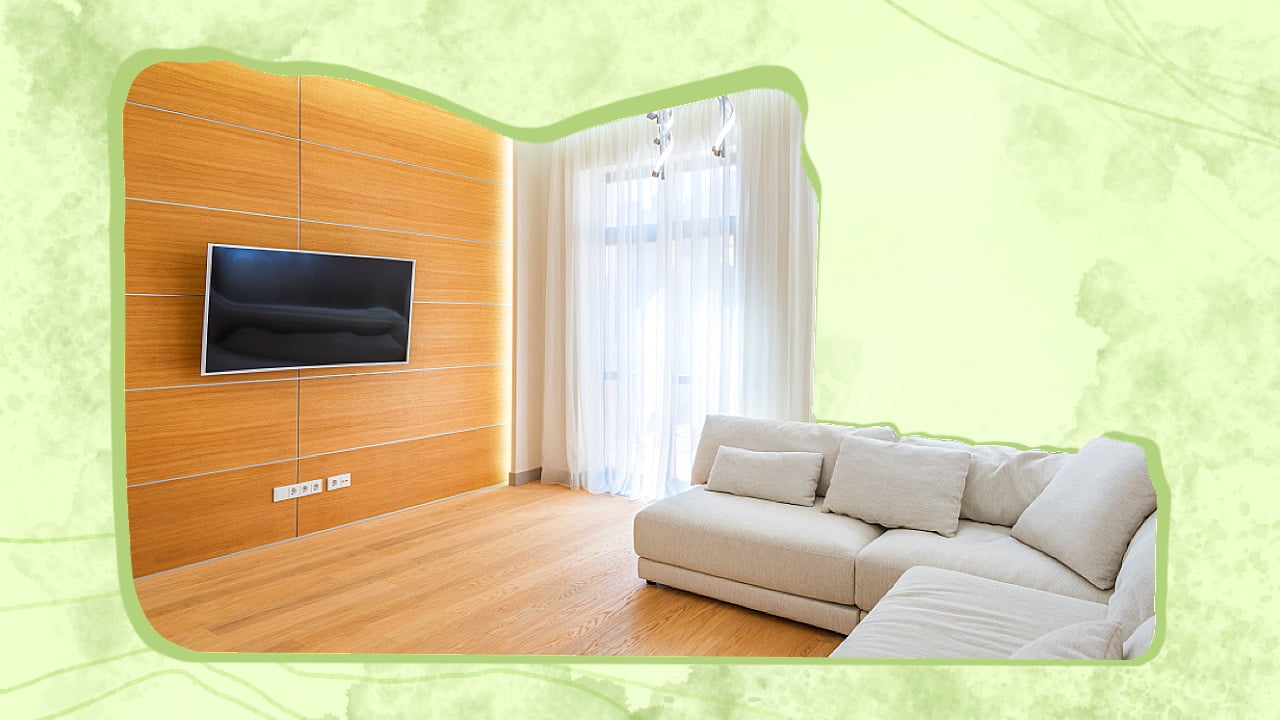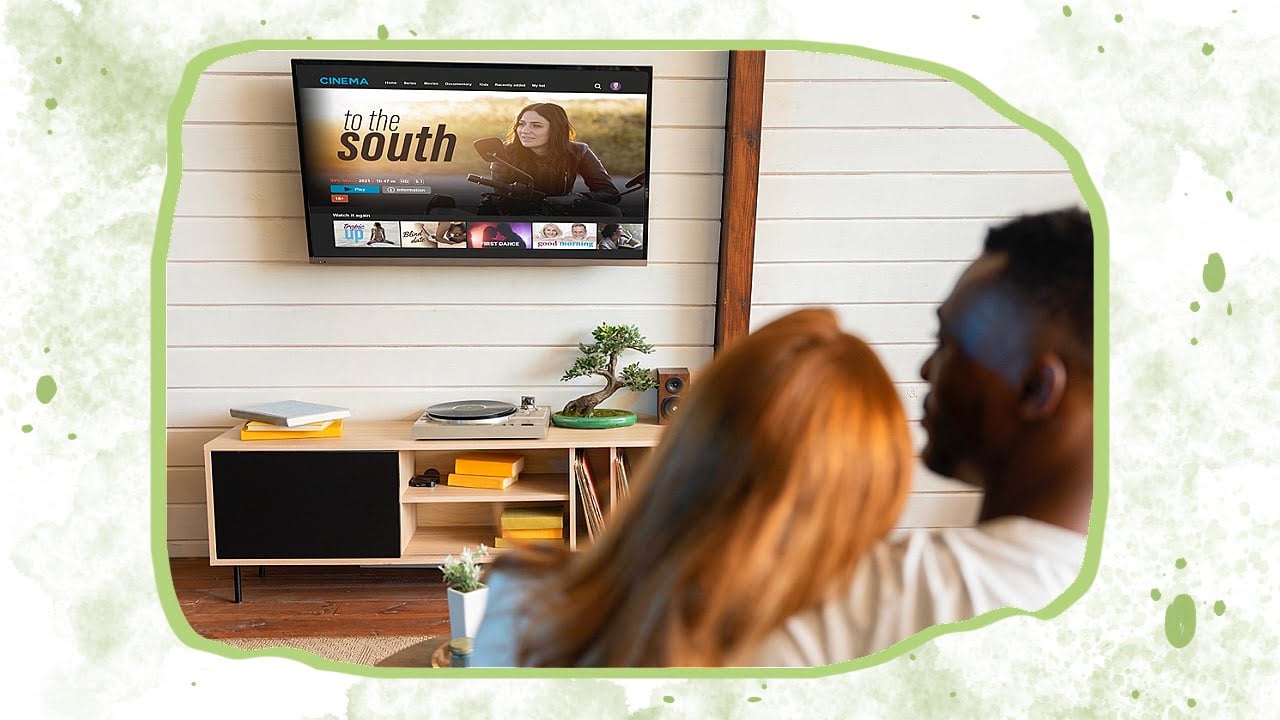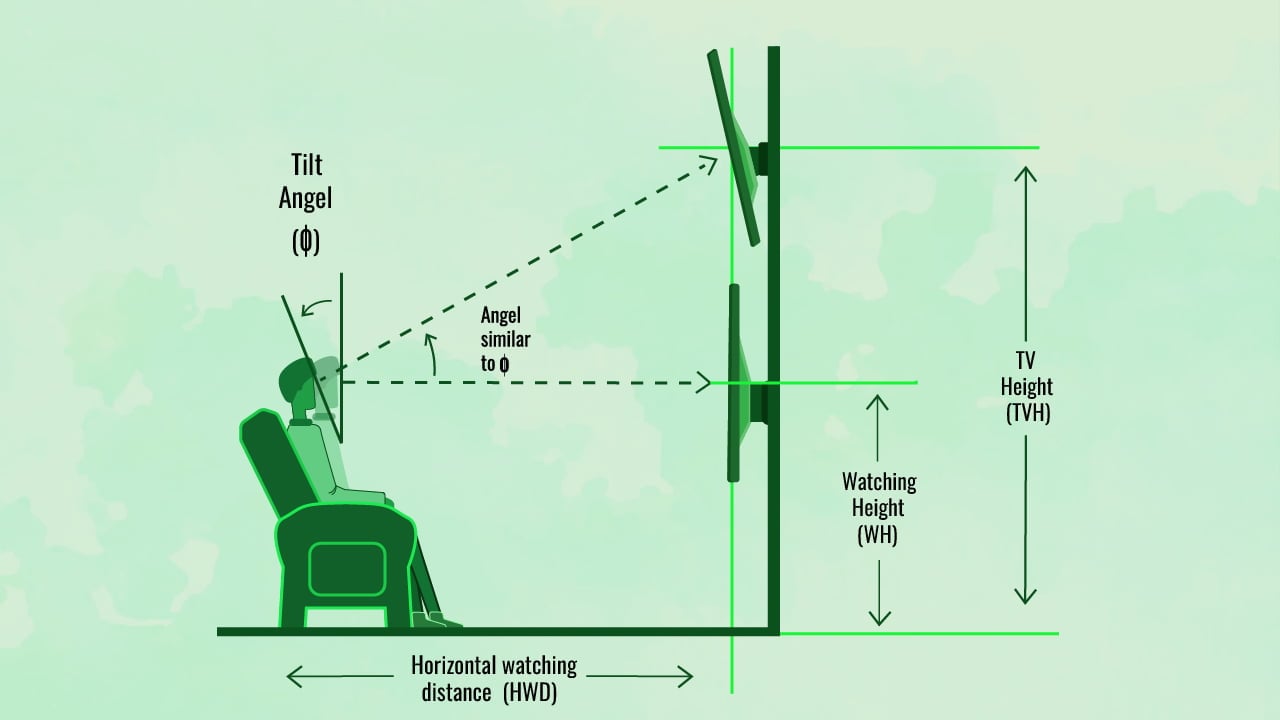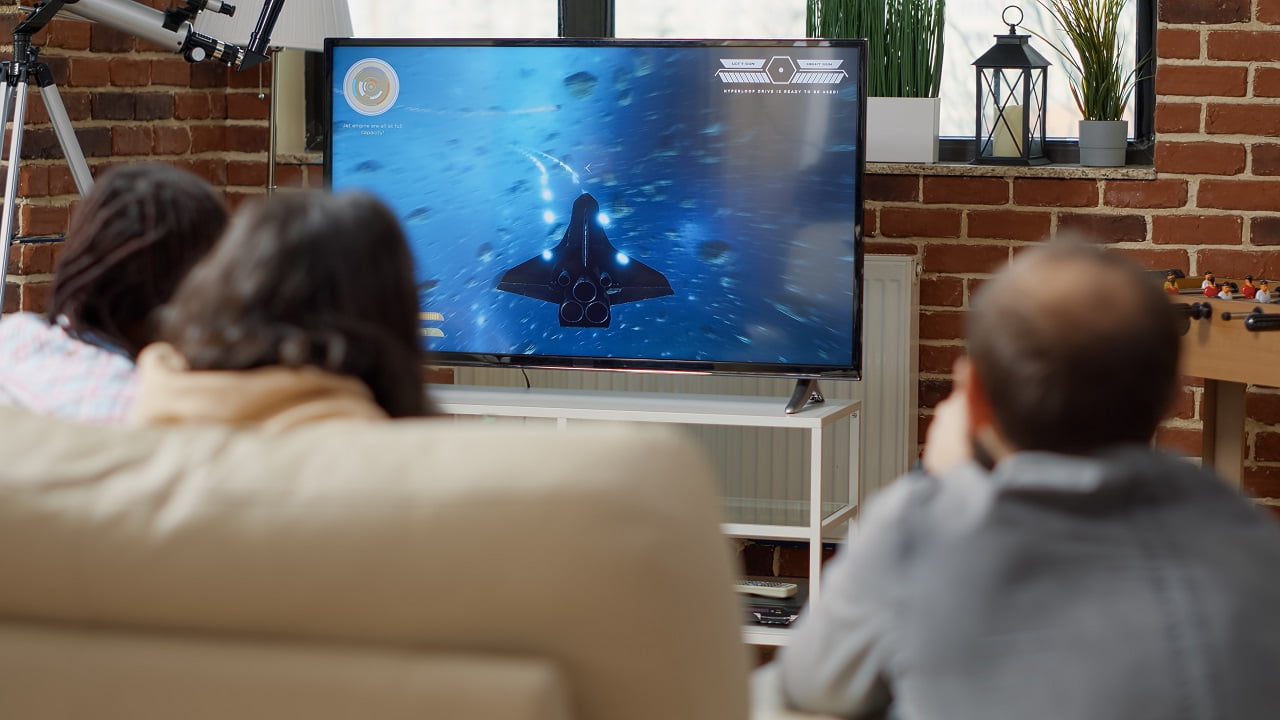The best TV mounting height and viewing angle depend on several factors, which can vary considerably from one case to the next. These factors include the TV size, viewing distance, clearance required, and location, among others.

Having the best TV-watching experience does not depend just on the quality of your TV.
There are other factors at play as well, and these include the height at which the TV is mounted and its viewing angles. Unsurprisingly, many people find it immensely confusing to determine the proper height at which the TV should be mounted for the best viewing experience.
This guide aims to help solve the problem by answering that question.
Factors Determining The Optimal Mounting Height For Your TV

It is crucial to determine the right height for mounting your television before starting to drill. Not doing so can lead to wastage of resources and time and also cause damage to your walls.
Aside from that, positioning the TV at an improper height can lead to discomfort while watching and will require removal and reinstallation, resulting in a lot of hassle. That is why you need to keep in mind a few factors when mounting the TV.
1. TV Size
When planning to mount your flat screen TV on the wall, the first thing to do is to measure its size. This size will determine how high it should be and will also help you get an idea of how much space it will require. Additionally, such information will be useful in case additional accessories need to be installed.
When taking measurements, make sure to measure the distance between the TV center to the floor. Also, the TV size is always measured diagonally, not horizontally or vertically. To help you out, I’ve mentioned some of the common distances ideal for different-sized TVs here.
In the case of 42-inch TVs, there should be a distance of 56 inches between the floor and the TV center. Similarly, 55-inch TVs should be mounted at a distance of 61 inches, while 65-inch ones should be mounted at a distance of 65 inches. Finally, 70-inch TVs should be mounted at a distance of 67 inches from the TV center to the floor.
2. Viewing Distance
The optimal viewing distance will closely depend on the TV size. Ideally, this distance should not be so much that the details are lost, nor should it be so less that it requires straining your neck. A larger distance between the viewer and the TV can result in a less enjoyable experience, while a smaller one can cause headaches.
Also, the viewing distance or VD will be affected by the optimal height, which will depend to a large extent on personal preference. You can divide the TV size (in inches) by 0.55 to know the optimal viewing distance.
Alternatively, you can use the following formula - (VD)=TVS*1.67. For instance, if you have a 55-inch TV, the optimal viewing distance will be 55*1.67, which will be 92 inches.
3. Viewing Angle
Another essential factor to keep in mind when mounting your TV is the viewing angle and eye level. This has to be calculated from the sitting position in which you are going to watch TV. Absolute precision is not required, but try to get a general idea of the location where the TV should be mounted to provide a great viewing experience without causing any pain.
If you want to be sure, follow the guidelines laid down by the Society of Motion Picture and Television Engineers (SMPTE). According to this, the viewing angle should not exceed 30 degrees. That being said, the maximum that the majority of people incline their heads when watching TV is between 10 and 15 degrees.
4. Individual Height
Individual Height is another factor to keep in mind when mounting your TV. And this problem becomes more complicated as the number of people watching increases. This is because people with different heights may find different viewing heights and distances comfortable. So, there is no standard solution that can fit everybody’s needs.
In such cases, you should think of the people who will be watching the TV and mount the TV accordingly. This will require measuring the ELH, which is the distance between the floor and your eyes while watching TV and is measured in inches.
Measure the distance from the average eye level to the floor while sitting. This will ensure that the TV should be comfortable for the maximum number of people.
5. Hanging Height And Location
The TV hanging height will also be determined by its location and will, in turn, determine its viewing angle. For instance, if the TV is to be mounted in a game room, there will most likely be a laid-back couch that will decide the optimal viewing height and viewing distance.
This will require considering the reclining angle or RA, which depends on your sitting position. Normally, when a person is sitting straight and watching TV, their torso forms a 90-degree angle with the floor, and the RA is zero.
But when you recline, the RA changes and has to be measured from the vertical angle. If you tend to recline more, the TV mounting height will need to be higher. And as mentioned, the maximum reclining angle lies between 10 and 15 degrees.
Additionally, different rooms will have seating options with varying heights. For instance, in the case of an open floor plan, there may be bar stools or a low chair or sofa. These may make it difficult to determine the best height for mounting your flat-screen TV.
In such cases, the best approach is to take the average of all sitting heights or the most used height when calculating the distance to the TV screen. Alternatively, if it is located in a home gym or game room, where most people watch TV standing up, I suggest using the average standing height when taking measurements.
6. Other Factors
There are some other factors that can determine the TV mounting height as well. For instance, a structural element, appliance, or furniture might prevent mounting the TV at the optimal viewing height. If that is the case, position the TV close to the viewing level while leaving space between the TV and the obstruction.
Such obstructions may include an entertainment center or shelves, in which case you should leave around four to six inches of space. And if you have children, it is a good idea to mount the TV at such a height that it is unreachable.
Some people also like to mount the TV over the fireplace, in which case, you need to install non-combustible barriers between the TV and the fireplace. This will protect the TV screen from damage caused by heat. Additionally, for such installations, I would advise checking the building regulations before installing the TV.
Determining The Ideal Viewing Angle
When mounting your TV, try to get the TV screen perpendicular to the eye level of the people watching it. That said, newer TVs come with high refresh rates, wider viewing angles, and greater clarity that allow more freedom so far as viewing angles are concerned.
So, even if you have the TV screen set at more than 25 degrees horizontally, you can still get a good experience while watching. It is more important to try and reduce glare while maximizing viewing comfort than focusing on the viewing angle itself.

Steps To Determine The Ideal TV Mounting Height
Before mounting your flat-screen TV, I recommend consulting with other household members to ensure that everyone gets the best experience while watching TV. You can use paper and a tape measure to mark the area where the TV will be mounted and ask the other household members to take a look. This will help ensure that it is the right spot for TV mounting.
Make sure you have all the necessary tools and the proper mount kit for the process before starting. Then, follow these steps to determine the ideal TV mounting height.
1. Attaching The Mounting Arms
First, you will need to screw the vertical brackets or mounting arms included in the mounting kit to the TV back. Once each bracket is attached, secure it to the wall plate in the same manner as when completing the assembly.
2. Taking Measurements
After the adjustable brackets have been secured to the wall plate, you need to measure the height of the mounting center up the wall. Take these measurements from three horizontal spots, and mark each spot using a pencil. This will indicate the point where the TV centerline will rest.
3. Determining The Top And Bottom Markings
Once you know where the TV centerline will lie, divide the TV height by two. Then, take a measurement of this distance and use a pencil to mark it over the center counting mark. This point will be the place where the TV top will lie against the wall.
Repeat the process for the TV bottom as well.
4. Creating Markings
The next step will involve creating an outline of the shape of your TV on the wall. You can use painter’s tape for the purpose and also make similar markings around the corners of the mounting plate.
5. Final Steps
Finally, use a level to check the outlines and ensure that it is the ideal TV mount height before starting the drilling process.
Calculating The Mounting Height Using A Mathematical Formula

Another way to determine the optimal TV height at which you should mount your TV is by using a mathematical formula. The formula is (TVMH) =0.22*VD+ELH. When using this formula, it is assumed that a reclining angle of 12.5 degrees exists.
To determine the height between the TV bottom and the floor, you need to measure the TV height before dividing it by two. Then, subtract this number from the result obtained by using the formula.
Or you could use another formula to calculate the screen height, which is TVMH=tan(RA)*VD+ELH. In this case, if the tan(RA) is zero, the reclining angle is absent, and you are sitting straight. So, the TV mounting height (TVMH) will be the same as the eye level height (ELH).
TV Mounting - Tools Required
Mounting your flat-screen TV may seem challenging, but using the right tools can help simplify the process considerably. That said, keep in mind that some tools are indispensable when you need to mount a TV, while others are only required to make the job easier.
The tools you will use to mount a TV include:
- Power drill
- Stud finder
- Screws
- Wall mount
- Level checker
- Hammer drill
Need For Additional Mounting Hardware
When considering the height at which you will mount your flat screen TV, make sure that the maximum amount viewers need to tilt their heads is 35 degrees. According to the Society of Motion Picture and Television Engineers, this is the maximum amount of tilt that allows comfortable viewing.
In cases where your flat-screen TV is mounted at eye level, this is easy, but when it is mounted at a significant height, it can cause neck strain. To avoid that from happening, you can lower the top of the flat-screen television, but it will require specialized wall mounts.
Instead of a standard stationary low-profile wall mount, you can use a tilting wall mount or a full-motion wall mount. A tilting wall mount can be adjusted vertically, while a full-motion one can be adjusted in different directions.
Whichever type of TV mount you choose, it should be suitable for the TV size and weight and should be easily attachable to your wall. Different types of walls, like plaster and lath walls, stud walls and block walls, require different mounts.
Benefits Of A TV Mount
A TV mount can make it easier to mount your flat-screen TV with a flat panel display to the wall and helps improve the viewing experience. It also offers other benefits, such as:
1. Helps Save Space
A TV mount can help you save a lot of space, which would otherwise be occupied by a table for keeping the TV. This means you can use the space below the TV in other, more productive ways.
2. Is Economical
Compared to a TV table, a wall mount is more economical, and you can even get different types of mounts. Thus, a TV mount is a good option if you want to save money.
3. Better Utility
In some situations, it is not possible to use a table for keeping the TV, such as when the TV has to be situated near a fireplace. TV mounts solve this problem by allowing you to mount the TV above the fireplace.
Things To Keep In Mind
1. Keep The Middle Third As The Focus
People usually focus on the middle third portion when they watch TV. That is why it should also be the area you should keep in mind when determining factors like viewing angles and viewing distance. And it is why I advise keeping the center of the TV as the point from where to estimate a comfortable viewing level.
2. Learn About The VESA Compatibility Of Your TV
Some TV manufacturers provide VESA mounting holes at the TV bottom, while others provide them in the center. Knowing the type of mounts your TV supports can make the mounting process significantly easier.
3. Consider The TV Weight
TVs can be incredibly heavy, and in many cases, it may not be possible to mount them to regular drywall using standard screws. You may need to screw into the wall studs to ensure proper support and prevent the TV from falling.
Tip
If you’re unsure about the proper height and angle for mounting your TV, I would advise calling up a professional mounting service. Such services can help determine the proper height and angle and help select the most suitable mount and additional hardware needed for the job.
Alternatively, you can get an adjustable mount that allows adjustments later after the TV has been mounted.

Conclusion
Determining the right height and angle to ensure the best TV viewing experience can be a bit challenging. However, it is possible to mount your TV as required by taking proper measurements, using the right hardware and tools, and investing adequate time.
While keeping in mind the factors mentioned above is important, it is also a good idea to plan for the future. This is especially vital if you plan to mount additional equipment on the same wall, such as a music system. Moreover, a well-placed TV mount can improve acoustics significantly by ensuring that the speakers are positioned optimally for an enhanced audio experience. Proper placement helps in directing sound waves toward the listener and mitigating distortions, thus providing an immersive audiovisual experience.
Considering the future and potential equipment additions will save you a lot of hassle in the long term and ensure the best viewing and listening experience in your home.
